

| Visitors Now: | |
| Total Visits: | |
| Total Stories: |

| Story Views | |
| Now: | |
| Last Hour: | |
| Last 24 Hours: | |
| Total: | |
The Occult Symbolism Of The 2012 Olympics Opening And Closing Ceremonies
By VC | August 17th, 2012 |
Watched by almost a billion viewers across all five continents, the 2012 Olympic ceremonies were, for a few hours, the focal point of the world. As is the case for most high-profile media events, the world elite’s messages, symbols and agenda were part of the show. We’ll look at the occult symbolism of the opening and closing ceremonies of the 2012 London Olympics.
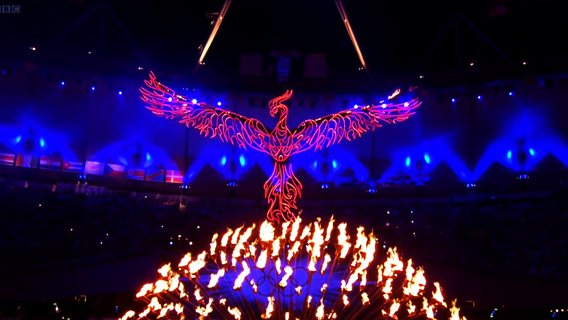
Olympic ceremonies are often among the most watched TV events on the planet. They are an exceptional chance for the host countries to showcase their greatness through a grandiose, elaborate and massive show. The 2012 London Olympics were no exception as England’s history, culture and accomplishments were thoroughly celebrated and applauded. Some moments were grand, others were funny; some were dark and even disturbing. Other moments were highly symbolic, reflecting the agenda of the occult elite. Given that London is one of the power capitals of the world, it would have been more surprising if the symbolism and philosophy of the global elite had not been infused throughout the ceremonies.
Of course, not everything was symbolic in that sense and not everything was in-your-face, but over the course of the several hours that the ceremonies lasted, a good deal of symbolism was communicated to billion of viewers around the world. Let’s look at the most symbolic moments of the 2012 London Olympics.
Opening Ceremony
The ceremonies were designed and coordinated by Danny Boyle, director of the movies Trainspotting and Slumdog Millionaire. Entitled Isles of Wonder, the opening ceremony focused on the history of England and the actors that influenced it. The journey began in ancient and mythical England then traveled through the industrial revolution, ending in modern times. The story was told using specific symbols and references that recall the occult side of Great Britain.
Green and Pleasant Land
The show begins in pastoral England, complete with farmers and cricket players. There are also many symbols alluding to its ancient mystical lore. The focal point of the show is a hill that is said to have magical properties: Glastonbury Tor.
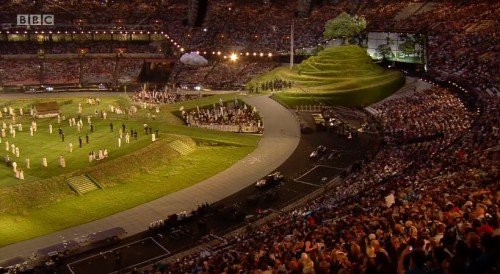
The mythical spirally hill named Glastonbury Tor overlooks pastoral England. This recreation of the Tor is topped by a giant oak tree, a tree considered sacred by Celtic Druids and representative of the Supreme Deity.
Glastonbury Tor is one of the oldest sacred sites in England. Believed to be at the intersection of powerful ley lines, the Tor is related to many mystical stories and legends. For instance, it is thought to be Avalon from the legend of King Arthur and his 12 knights, a story that is esoterically associated with the sun and the twelve signs of the zodiac. Another legend claims that Joseph of Arimathea, the great uncle of Jesus Christ who was a tin merchant, brought young Jesus on a trip to Glastonbury. He later came back to the site and threw the chalice used by Jesus during the last supper (the fabled Holy Grail) in Chalice Well – an area of Glastonbury said to have magical powers. Archeologists have also discovered that the construction of the Gastonbury abbey involved sacred geometry “known by the builders of Egyptian pyramids” and passed down through societies of stonemasons (the originators of modern Freemasonry).

The “real” Glastonbury Tor, topped by St. Michael’s Church. The hill is the site of Christian pilgrimages and seasonal rituals practiced by ritual magicians, witches, pagans, and of various occult and spiritual festivals.
The presence of Glastonbury Tor in the Olympic stadium provides a definitively mystical and esoteric undertone to the opening ceremonies.
While countrymen work the land and run around maypoles (which incidentally bear a cosmic and phallic occult meaning), a young boy in the crowd stands up and sings part of a classical English hymn, William Blake’s Jerusalem.
William Blake is often described as a “visionary” whose artistic works were heavily inspired by Druidism, Gnosticism and Freemasonry (his depiction of the “Grand Geometrician” holding a Masonic compass is above the Rockefeller Center in New York). While some of his creations had Christian connotations, they were often told from a Gnostic and esoteric point of view. Jerusalem refers to the apocryphal story described above of Jesus visiting the “green and pleasant land” of Glastonbury with his great-uncle, Joseph of Arimathea.
And did those feet in ancient timeWalk upon England’s mountains green?And was the holy Lamb of GodOn England’s pleasant pastures seen?And did the Countenance DivineShine forth upon our clouded hills?And was Jerusalem builded hereAmong these dark Satanic Mills?
The Industrial Revolution
After the singing of the hymns, men in top hats, enter England’s Green and Pleasant land and bring about important change.

The men in top hats survey the land and shake each hands. This small elite group will coordinate the industrial revolution and get the masses to work.
The top-hat guys are lead by civil engineer Isambard Kingdom Brunel, who stands at the base of the Tor and give a speech quoting Shakespeare’s The Tempest. The oak tree then rises from the ground and hundreds of workers emerge from under the Tor and begin transforming England’s landscape.
At this point, there are a few facts that deserve to be pointed out. First, the legend of King Arthur stipulates that the top of the Tor provided entrance to Annwn, the ancient word for the Underworld. Second, the official name of the segment about the industrial revolution is Pandemonium, which is the name of the capital of Hell in Milton’s classical work Paradise Lost. These clues indicate that London did not become New Jerusalem (a metaphor for heaven) as stated by Blake’s hymn, but literally hell on earth. And all of this pandemonium was brought about by a handful of elite men who got thousands of workers apparently emerge from the underworld and build industrial England.
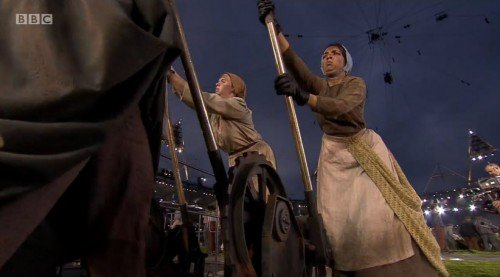
Peasants of the country worked in hellish conditions to bring to reality the elite’s vision.
It is now an established fact that the bringing down of monarchies and the push for industrial revolution during the 18th century was heavily influenced by Secret Societies such as the Grand Orient Freemasons and the Bavarian Illuminati, who called for an “unshackling of science” and a “new age of Reason”. The men in top hats coordinating the transformation can therefore be associated with the secretive groups that historically engendered a new economic, political and social system during the 18th Century.
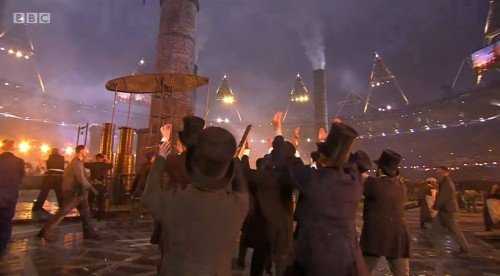
The unfolding of “Pandemonium” is depicted using two very distinct groups: Elite “thinkers” who decide and oversee the project and “workers” who work in the field and take orders. All of this happens in the Olympic stadium, which is surrounded by giant triangles with illuminated capstones – a classic symbol representing an elite ruling above masses.
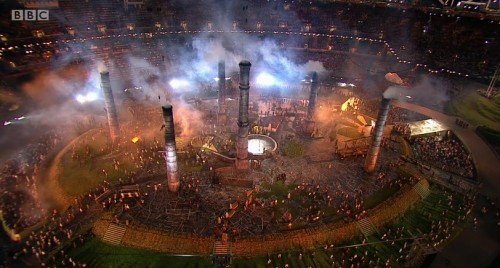
The final product of Pandemonium is one big messy grey mass full of “Satanic mills” and seven phallic chimneys spitting out smoke.
Leave the Kids Alone
The next important sequence of the ceremony paid tribute to the National Health Service (NHS) and Great Ormond Street Hospital (GOSH). The set combined sick kids on hospital beds with characters from English children’s literature and had a very strange and dark undertone from the start, when it began with the theme from The Exorcist, which is, in case you don’t know, a movie about a child possessed by the Devil. Odd choice.
The sequence begins with children on hospital beds who get put to sleep by nurses. Then J.K. Rowling appears and reads a quote from Peter Pan alluding to Neverland, which becomes real in the “two minutes before you go to sleep”. I couldn’t say if that was done on purpose, but many elements of this set, mostly the mix of vulnerable children in a hospital with fairy tales and the concept of blurring the lines between reality and fiction, are all associated with mind control programming. Like the Wizard of Oz and Alice of Wonderland, the story of Peter Pan is heavily used in mind control programming as victims are told to escape to “Neverland” while inducing dissociation from reality.
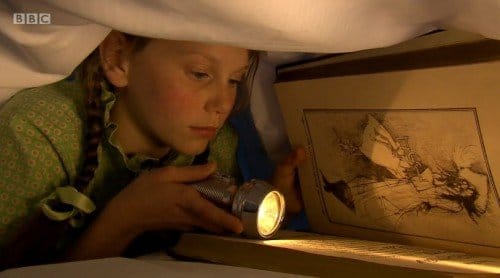
A child reading Peter Pan. On the page, we see a scary Captain Hook standing next to … a kid strapped to a bed? According to Franz Springmeier, Monarch programming uses a technique called “Peter Pan Programming”, in which Captain Hook represents the handler.
After J.K. Rowling’s appearance, hordes of ghouls and villains from English literature enter the stage, running after the children and scaring the crap out of them.

As if under the spell of this gigantic figure of Lord Voldemort, this young girl’s bed hovers high above the ground. Does this represent dissociation engendered by intense trauma?
While the evil characters run after the children, the nurses are completely immobile and powerless as if declaring “Health workers can do nothing when the elite’s mind control is happening behind closed doors”.
Luckily, a whole bunch of Mary Poppins fly down and shoo away the scary characters. Then, a rather creepy giant baby appears on stage.
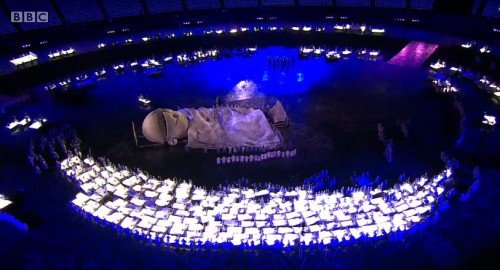
Is it just me or does the giant baby have a big “separation” on the forehead?
The odd combination of children in a hospital and fairy tales might have been a clever way to combine two important aspects of British culture. It can also be a sick way of referring to Monarch mind control. On that note, let’s bring out Mr. Bean!


